By now, most people are aware that the farm bill is better described as the food and farm bill, as it focuses on many demographics besides farmers, something it hasn’t always been able to boast about. But, with every new farm bill, there are groups that fight for more representation in the legislation; as growing exposure is given to the concerns and needs of a diverse society, the farm bill becomes a more inclusive policy.
One such group at the forefront in 2023 is Native Americans.
There are multiple organizations advocating for Native American concerns in the farm bill, the Native Farm Bill Coalition being one. Founded in 2017, the organization is a collective voice of 170 tribes, intertribal groups, other Native organizations, and non-Native allies working together to advance policy agenda that benefits tribal lands and Native communities.

Another organization, The National Congress of American Indians, published a farm bill brief in order to establish policy priorities for the 2023 renewal. For them, and their partnering organizations, it acts as “a mid-point status report about how the Farm Bill is working for Indian Country and how it could work better, this brief serves as an important education and advocacy tool for tribal leaders and key decision-makers as they deepen their dialogue with federal policymakers about: (1) how best they can strengthen implementation of the current Farm Bill provisions; and (2) what is needed in the next Farm Bill, slated for passage in 2023.”
According to NCAI, there were a lot of Indian Country priorities left out of the bill, however, and they are looking for improvements in the upcoming renegotiation. There are about 15 recommendations listed in the brief, including:
- Extend Tribal Self-Governance under the Indian Self-Determination and Education Assistance Act of 1975 to the Supplemental Nutrition Assistance Program. Specifically, and enable tribal nations to administer SNAP along with other federal food assistance programs and eliminate asset tests that do not align with SNAP requirements.
- Expand Existing Tribal Self-Determination Opportunities and Establish Tribal Self-Governance Authority under the Indian Self-Determination and Education Assistance Act of 1975 in the Food Distribution Program on Indian Reservations (FDPIR) and other Food Assistance Programs at USDA. Specifically, include the Temporary Emergency Food Assistance Program; exercise current authorities enabling tribal management of existing food assistance programs through self-determination contracts and pursue authority for tribal management of food assistance programs through self-governance compacts; support additional flexibilities and Tribal Self-Determination/Self-Governance in FDPIR to improve tribal capacity for local purchasing; and reform FDPIR to permanently include traditional Native foods.
- Increase Funding for Tribal-Specific Projects under All USDA Water and Environmental Grant Programs by $210 million. Specifically $200 million in tribally set-aside grant funding within USDA Rural Development for rural and Native Alaskan villages, water and waste disposal grants and loans to alleviate health risks on tribal lands, emergency community water assistance grants, and $10 million to support tribal assessments on aging drinking water and wastewater infrastructure.
In March of 2023, a group of Native American agricultural leaders sat at a roundtable for the U.S. Senate hearing. The purpose of the hearing was to create a bipartisan recommendation list for the Senate Committee on Agriculture, Nutrition, and Forestry.
In attendance was Democratic Sen. Brian Schatz of Hawaii, who stated the current farm bill is the first to seriously bring Native Americans concerns to the table.
“The 2018 farm bill broke barriers, but more work needs to be done,” Schatz said. “The next farm bill is another opportunity for us to collaborate and build on this incredible progress, and to further advance federal agricultural policy that includes Native priorities.”

In the 2018 bill, 63 individual provisions were authorized, and included strengthening tribal self-governance and the management of nutrition programs to investing in economic development opportunities.
More specifically, the 2018 farm bill implemented the 638 project through the Food Distribution Program on Indian Reservations, an alternative to SNAP for tribes and approved households near reservations who may not have access to SNAP offices or authorized food stores. There are approximately 276 tribes who currently benefit from this program, and according to a USDA fact sheet, “Average monthly participation for FY 2019 was 83,800 individuals. In FY 2019, $153.0 million was appropriated for FDPIR – approximately $49.762 million for the Federal share of local level administrative costs, and the remainder for food purchases.”
According to the U.S. Department of Agriculture, through the 638 project, participating tribes are able to:
- select one or more foods that they would like to procure for inclusion in the food package,
- identify the food(s) in the food package that they would like to supplant with the tribally procured food(s),
- establish contract(s) with a vendor(s) to procure the selected food(s), and
- distribute the tribally procured food(s) alongside other USDA-provided foods in the FDPIR food packages distributed to their tribal members.
Additionally, the project:
- supports tribal self-governance by allowing participating tribes to purchase similar foods of their choosing, supporting tribal dietary preferences;
- allows tribes to purchase foods through commercial vendors of their choice;
- supports tribal economies as tribes may choose to contract with local, regional, and/or tribal vendors; and
- provides FNS with an opportunity to see how tribal procurement may work under a food distribution program model across region, program size, and food selection.
The program is authorized through 2023, and advocates encouraged expansion of this program into the next farm bill, while also seeking the same applicability to all USDA programs, which include nutrition, forestry and food safety inspection.
During the hearing in March, the 638 project wasn’t the only topic brought up. Leaders also mentioned improving access to USDA employees and providing those employees with education to properly inspect Native food products, as well as establishing work training programs and having a tribal self-governing office. Lack of access to all the aforementioned concerns has created a barrier for domestic sales for some tribes.
Another concern is access to credit and risk management- which is complicated due to much of Native agriculture lands being held in trust by the Department of the Interior and banks not making loans on tribal lands or equipment as collateral. During the hearing, leaders asked for a strong crop insurance program, as this can be used as collateral by certain banks.

According to the Congressional Research Service, other provisions in the 2018 bill include:
- Tribal Promise Zones. Provides federal agency resources and technical assistance to work with local leaders to boost economic activity and job growth, improve educational opportunities, reduce crime, and leverage private investment to improve the quality of life in these designated areas.
- Tribal Advisory Committee. Creates a new Tribal Advisory Committee to provide advice to USDA on tribalrelated issues and policies throughout the department.
- Equity in Educational Land-Grant Status Act of 1994. Adds Nueta Hidatsa Sahnish College and Red Lake Nation College to the list of 1994 institutions. Reauthorizes endowment, capacity funds, and grants for tribal colleges.
- New Beginning for Tribal Students. Creates a new Native American student scholarship fund for tribal students attending land-grant universities and colleges.
- Supplemental Agricultural Disaster Assistance. Adds tribes and tribal organizations as eligible for support.
- Report on Farm Credit System. Requires a study on the availability of farm credit to tribes and tribal producers.
- Underserved Producers. Includes tribal producers in definition of underserved producers and requires they receive adequate federal crop insurance coverage from USDA. Loan Refinancing (Title IV Joint Explanatory Statement). Expresses intention that an existing loan may be refinanced using the Substantially Underserved Trust Area program.
- Technical Assistance Program. Establishes a permanent Rural Development Tribal Technical Assistance Office across all areas of rural development funding.
- Food Distribution Program on Indian Reservations. In addition to the law’s reauthorization of the program, increases funding for tribes’ FDPIR administrative costs and authorizes USDA to develop a demonstration project for one or more tribal organizations to procure foods for FDPIR packages under “638 contracts.”
- Tribal Forest Management Demonstration Project. Authorizes USDA and the Department of the Interior to enter into “638 contracts” on a demonstration basis, whereby a tribe or tribal organization may perform the administrative and management functions of programs implementing the Tribal Forest Protection Act.
- Prohibition on Slaughter of Dogs and Cats for Human Consumption. Prohibits the slaughter/transportation of dogs and cats for the purpose of human consumption, with a religious ceremony exception provided for Indian tribes.
- Tribal College and University Essential Community Facilities. Reauthorizes at $10 million annually.
- Water Systems for Rural and Native Villages in Alaska. Reauthorized at current funding level and includes eligibility for tribal consortia (with a 2 percent set-aside for the consortia) and Alaska Native villages.
- Hemp Production; Interstate Commerce. Authorizes states and tribal authorities to develop and regulate hemp production in compliance with USDA regulation.
- Eligibility, Representation, and Participation of Indian Tribes in Various Titles. Rural Development, Nutrition, Forestry, Conservation, Horticulture, Trade, and Miscellaneous.
While the 2018 farm bill was a landmark bill, which created more opportunities for tribal communities, it is clear there is still a long way to go in establishing a fully diverse and inclusive food and farm bill that meets the needs of an equally diverse society.
Markie Hageman Jones majored in agribusiness at Fort Hays State University. She is actively involved in her state Cattlemen’s Association, Young Farmers chapter, and National Cattlemen’s Beef Association. Her AGDAILY.com articles can be found here.



